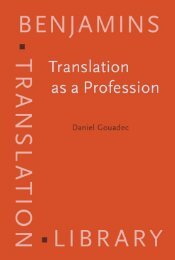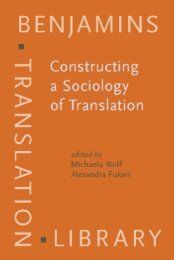Translation Theories.pdf
Translation Theories.pdf
Translation Theories.pdf
You also want an ePaper? Increase the reach of your titles
YUMPU automatically turns print PDFs into web optimized ePapers that Google loves.
According to Livia(2003), when translating from a language in which there are many<br />
linguistic gender markers into a language which has fewer, either gender information is lost, or it is<br />
overstated, where in the original it is more subtly presupposed.<br />
Al-Quini (2001) argues that the translator has to make a decision between the masculine<br />
and feminine pronouns and the gender agreement entailed thereof.<br />
III. METHODOLOGY<br />
III.1. RESEARCH DESIGN<br />
The researcher chooses this subject because in translating the third- person pronoun and<br />
also in translating some pronouns or nouns whose gender is not obvious, always the translators<br />
face many problems. So the researcher decides to look at this problem carefully in order to find a<br />
way for having a good translation.<br />
The researcher tries to find some ways in order to translate the third-person pronoun in<br />
the possible contents. In languages, that are said to have a pronominal gender system, ’gender’ is<br />
marked solely on personal pronouns (Corbett,1991;12) .Translating pronoun between languages<br />
that encode gender differently in their pronoun systems has been always problematic, where as<br />
some languages like Persian, do not encode gender distinction in their pronoun system at all.Al-<br />
Quiani argues that the translator has to make a decision between the masculine and feminine<br />
pronouns and the gender agreement entailed thereof. But as the sex of the referent in the source<br />
language is not known, the unknown masculine rather than the feminine form is used. Nissen<br />
(2002) argued that in such cases, where target language does not mark gender in predicate<br />
construction, then the translator should resort to other means to convey necessary information<br />
about the sex of the referent.<br />
III.2. SAMPELS<br />
The researcher chooses the samples accidentally from the following books named:<br />
· “of Mice and Men”, which was written by ‘John Steinbeck’ and was translated by ‘Elham<br />
Tabe Ahmadi’.<br />
· ‘Sherlock Holmes’, which was written by Arthur Conan Doyle ‘and translated by ‘Monire<br />
Kordestany’.<br />
· ‘the Alchemist ‘ which was written by ‘Paulo Coelho’, with two translation 1) Arash Hejazi<br />
2) Dr. Bahram Jafari’s translation.<br />
· “The biography of Avicenna” which was written and translated by “Eqbal Farhat”.<br />
III.3. DATA ANALYSIS PROCEDURE<br />
The researcher selected some sentences from the above mentioned books, and in some<br />
parts she compared the sentences with each other in order to see which one is the best.<br />
There are some sentences which are collected from the book “SHERLOCK HOLMES”:<br />
خستھ و ناراحت بھ نظر میرسید و چھره اش بسیار رنگ پریده بود.<br />
She looked tired and unhappy and her face was very white.<br />
In this sentence as you can see the translator cannot decide who the subject is and what the<br />
gender is!<br />
· بنابراین برای پزشک شدن درس خواند، و بھ ھند رفت.<br />
So he studied to be a doctor, and went out to India.<br />
Here again the gender is not obvious in the Persian sentence.<br />
· یکبار در ھند از خدمتکار ھندی اش عصبانی شد و او را کشت.<br />
The <strong>Translation</strong> <strong>Theories</strong>: From History to Procedures<br />
Edited by Zainurrahman<br />
Source: Personal Journal of Philosophy of Language and Education<br />
(http://zainurrahmans.wordpress.com) 97<br />
·

















